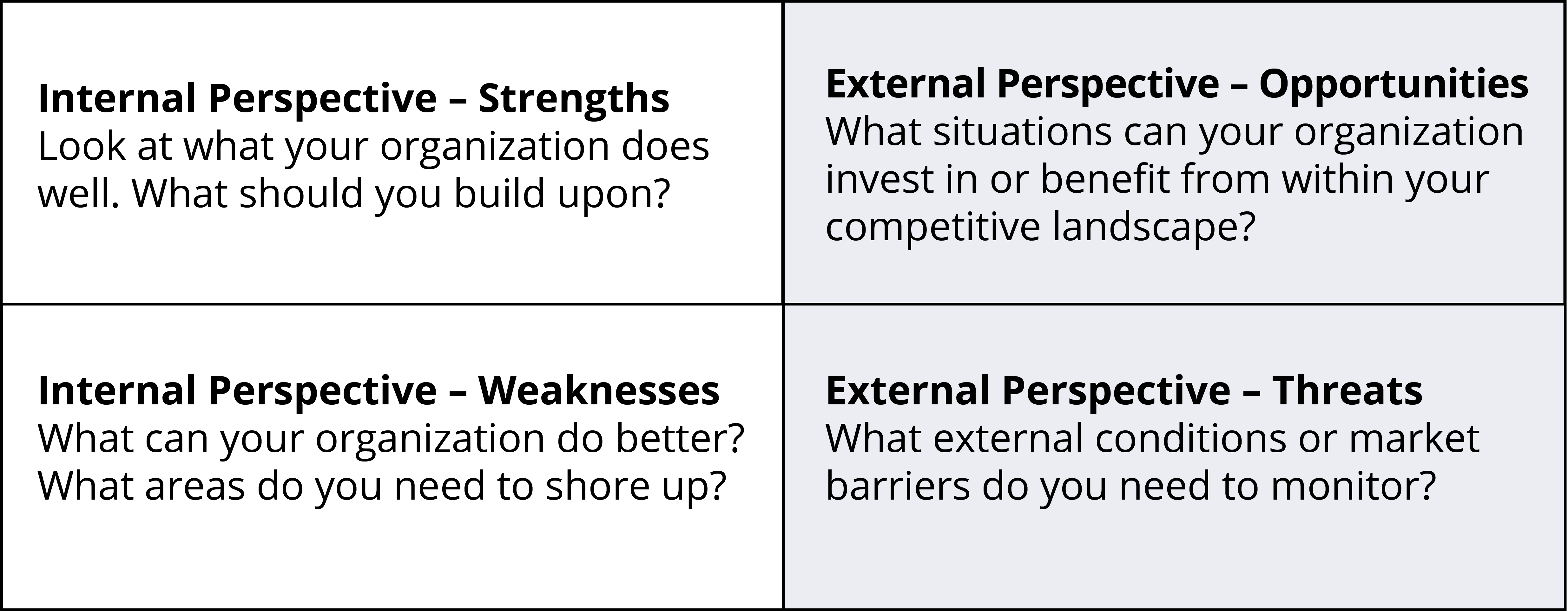In Part 2 of 4 in our newsletter series to help guide your organization to complete your yearly planning, we will be covering how to determine your organization’s position in your marketplace and assess what is affecting your organization’s performance internally and externally. If you haven’t already read Part 1, you can check it out here.
The purpose of completing these exercises is to take a good, strategic look at your organization’s position in the marketplace and your core competencies so you can make informed decisions during the creation of your strategic roadmap.
Timeline:
- 2-4 weeks
Outcomes:
- An analysis of your competitors and competitive environment
- A drafted and prioritized SWOT
Step 1: Identify Your Strategic Issues
The fist step is to identify strategic issues within your organization. These are often the issues or problems that are driving your organization to begin the strategic planning process. These issues can range from issues, shifting markets, new opportunities, or the any number of things that keep your leadership team up at night. Watch the video here to learn more.
The outcome from identifying your strategic issues is to create a short punch list to consider as you begin building your strategic roadmap.
Questions to Ask:
- How are we going to grow, organize, or stabilize our organization?
- How are we going to diversify our revenue and reduce dependence on a few major customers?
- Do we need to innovate or change our products or services to meet the needs of our customers?
- How do we improve our operational structure, remain efficient, and remain a competitive employer?
Step 2: Analyze Your Competitive Landscape
With your strategic issues identified, you’ll want to look at your operating environment and competition to analyze environmental trends and understand where your organization fits in the marketplace.
Conduct Your Environmental Scan
Conducting an environmental scan or analysis helps clarify your operating environment. We recommend conducting a PEST analysis (Political, Economic, Social, Technological) within your operating environment. Look at any political (or legal), economic, social, or technological environmental factors that may be affecting your organization.
Next, you’ll want to look at your competition to identify any market opportunities or threats you may be faced with from your competitors. Clearly understanding what value competitors are providing to prospective customers is important. The reason to do a competitive analysis is to assess the opportunities and threats that may occur from those organizations competing for the same business you are. You need to have an understanding of what your competitors are or aren’t offering your potential customers. Here are a few reasons it’s critical to complete a competitor analysis during the strategic planning process:
- Understand what your competitor’s value proposition is to prospective customer
- To help your organization assess whether its competitive advantage is truly competitive.
- To help evaluate your strategic decisions in your marketplace.
BONUS: During this exercise, you may consider defining customer segments to further understand how you are providing value to each set of your customers. Watch the video on customer segmentation here.
Step 3: Complete Your SWOT
Conducting a SWOT (Strengths, Weaknesses, Opportunities, Threats) analysis allows you to clearly see the internal and external factors that need to be considered and capitalized on during the strategic planning process. It will help you outline what you need to capitalize on, shore up, invest in, and monitor. Watch our video on conducting a SWOT analysis here.

Structure your SWOT analysis like the matrix above and discuss these questions with your planning team. The outcome should be a fully-drafted SWOT analysis that outlines 10-15 bullets prioritized by impact and need for you to consider as you complete the rest of the planning process.
Now that you’ve completed the assessment of your current market and your SWOT, your planning team can move on to designing your corporate strategy. Read part 3 of 4 where we outline how to build your strategic foundation and organization-wide strategies!












Dear Author
Thank you for putting in public domain this important resource material. I found it relevant and useful